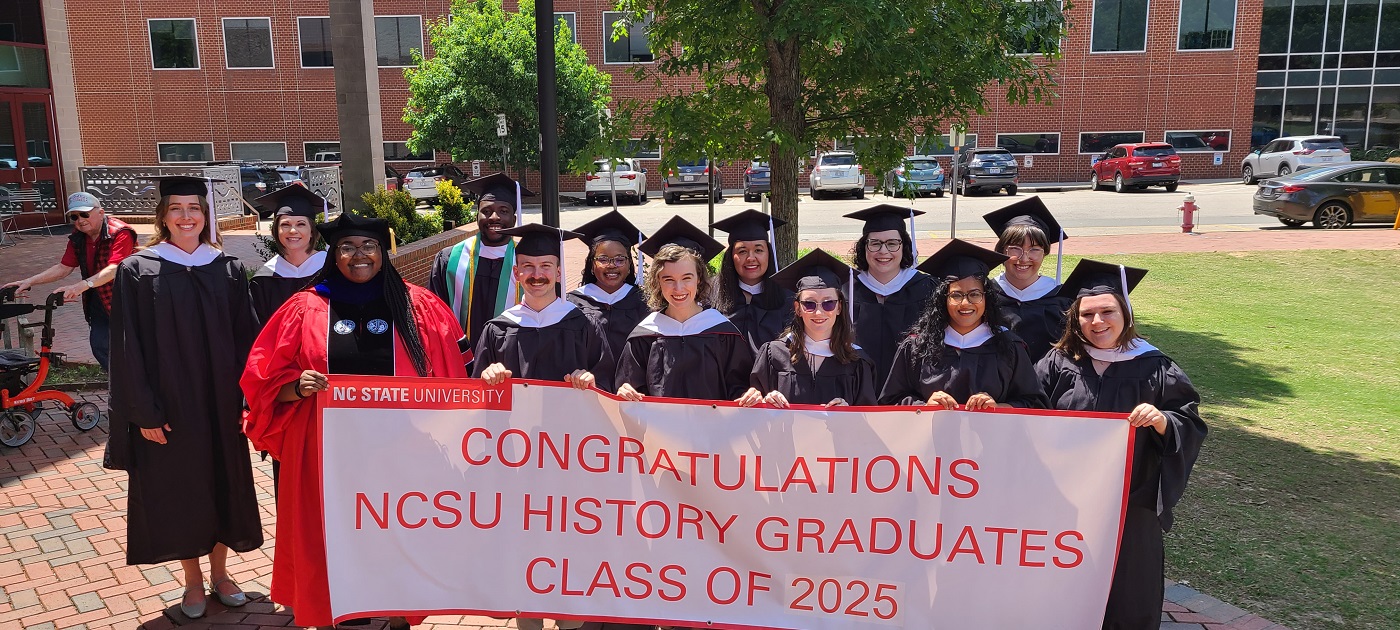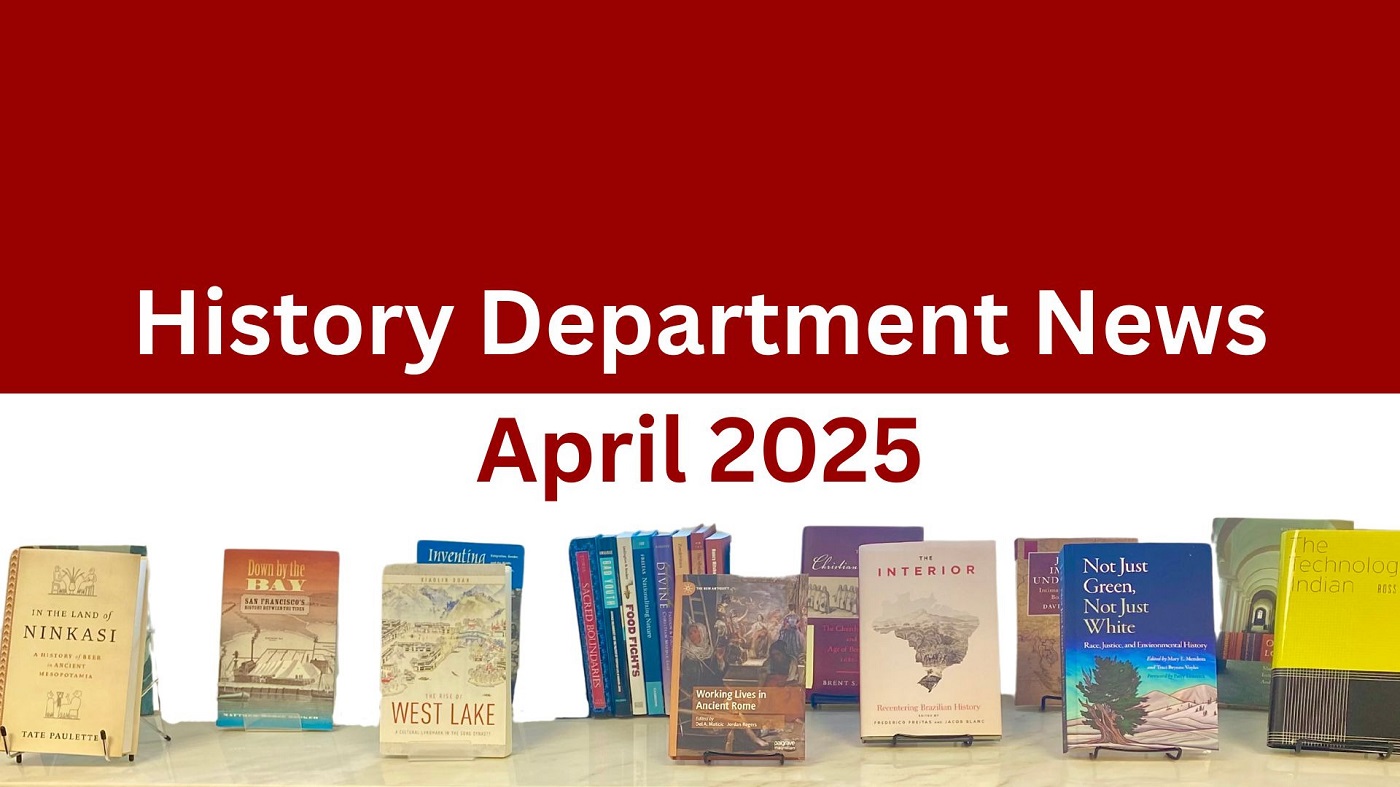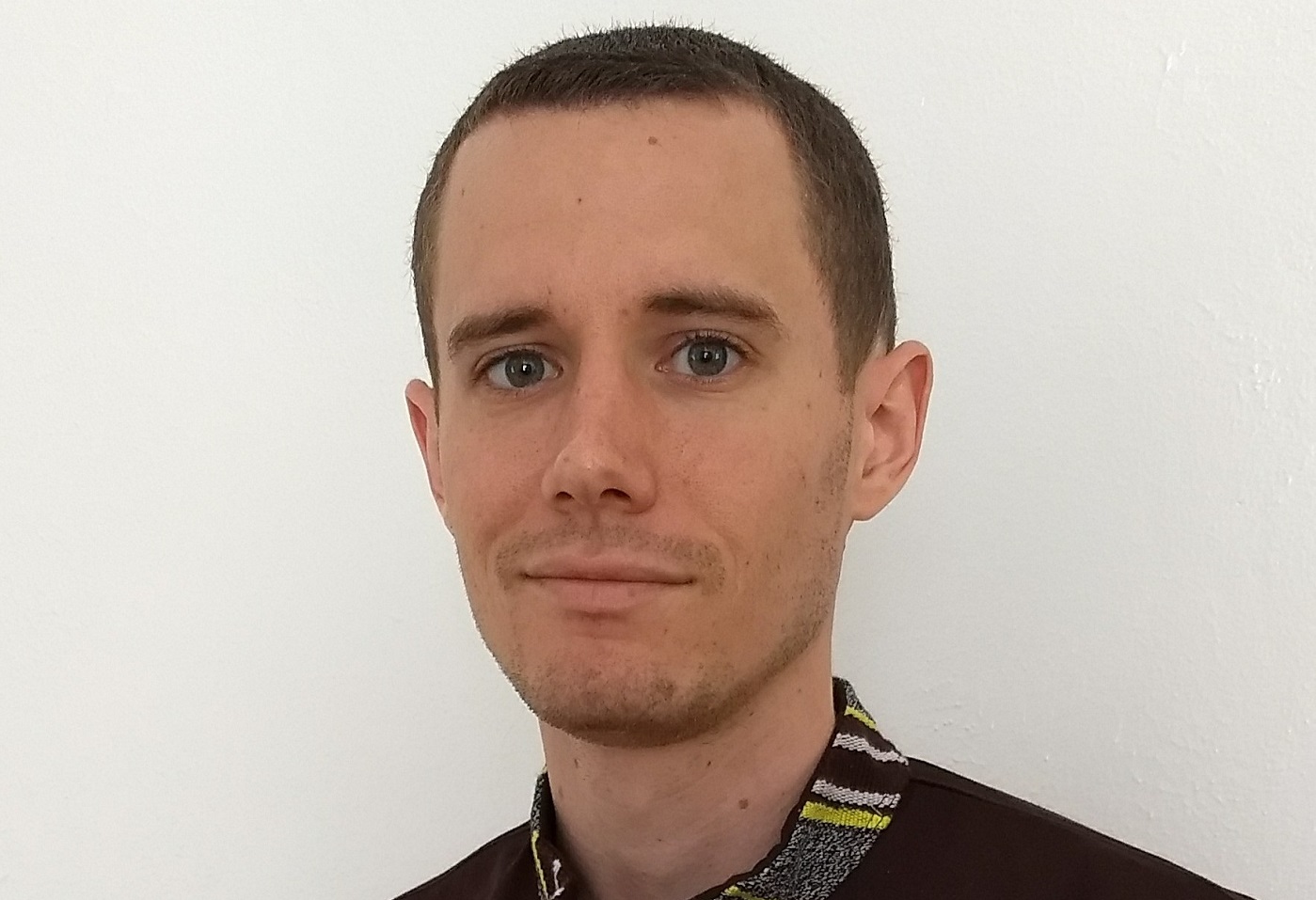Graduate Students Present Work at National Council on Public History Conference
Public History graduate students, Katie Schinabeck, Sarah Soleim, Lisa Withers, and Hanna Howard attended the 2018 NCPH conference in Las Vegas this past Spring. Working within the theme of “Power Lines,” the students projects focused on addressing the power of public history to define, cross, and blur boundary lines.
What was your poster and sessions about? How did it/they connect to the conference theme of “Power Lines”?
Lisa: Hanna and I co-presented a poster with colleagues, Sarah and Katie, on the organization, Historians for a Better Future (HBF). The poster focused on HBF’s work as a model for public historians to use their professional training to address contemporary problems by facilitating public dialogue. HBF works to create opportunities for all community members to learn the historical context of modern issues and to engage in collective conversations about contemporary topics in order to break down “power lines” as every community member has a voice in determining how we solve social problems. The poster highlighted Free History Lessons, training sessions, and teach-ins as key methods HBF used thus far to share historical knowledge and to facilitate community discussion.
Katie: I participated in a panel about researching the Green Books – a series of African American travel guides published with the goal of easing travel for African Americans during the era of Jim Crow. The panel included a group of scholars from different disciplines who have researched the properties listed in the Green Books. While they’ve found that many of these buildings don’t exist, they hope to raise awareness of the historical significance of the buildings that do. The fact that many don’t exist directly relates to “power lines” and the idea that the avenues of power influence the built environment. For example, many of these buildings are no longer extant because of urban renewal. Historic preservation of these structures can be a tool to give community members power to protect community spaces. The panel was an great opportunity to share our work, and more importantly, to connect with other public historians working on the Green Books.
Sarah: I participated in the working group, Disrupting Institutional Power. Our goals were to identify opportunities and barriers for establishing cross-institutional partnerships to enrich public history education and strengthen regional public history networks throughout the United States. For our group, “power lines” meant considering the communication channels that already exist between universities, museums, historic sites, and state historical agencies and examining ways we, as students, professors, archivists, librarians, and museum directors, might come together to create educational opportunities and develop standards and best practices for public history programs. We also considered the bureaucratic and economic “power lines” that limit our ability to see ourselves as a broader public history community.
Our conference meeting was preceded by online discussions available on Denise Meringolo’s website here. At the conference, we explored what a regional model for public history education might look like. Break-out groups considered how faculty could “sell” a regional model of public history education to university administrators, developed potential mission statements and organizational structures for regional programs, assessed the resources needed for maintaining long-term collaboration, and examined how better cross-institutional collaboration could improve internship experiences. In the weeks ahead, these break-out discussions will come together into a rough proposal or recommendations on how to build cross-institutional collaborations into public history programs.
What did you take away from the poster presentation and other events you participated in?
Lisa: Public historians already have a brimming toolbox of methods for engaging with the public. However, the responses we received from our poster suggests that we, as public historians, do not necessarily need to develop more tools but shift our attention to thinking about innovative ways we can use the tools we already have in our possession. How can we wield our community engagement tools in such a way that resonates with our multigenerational and often divisive society? For example, how could we take pedagogical techniques commonly found in museum education and use them in street venues, such as a festival, to reach and include a larger audience in public dialogues on key issues?

Hanna: During the poster session in particular, I was struck by the projects our fellow public historians undertook over the course of the past year. Taking a break from presenting to meet other poster session participants and getting to know them and their work was not only inspiring, but instructive in terms of what methods and practices we can use to meet our communities’ needs and, indeed, which communities we might still need to start conversations with in the first place.
How did you approach networking with other public historians at the event? How did you negotiate working with other scholars on panels and in working groups?
Lisa: I carried out two roles at NCPH: poster co-presenter and member of the Professional Development Committee. A part of my service to NCPH as a committee member is helping to organize and carry out the annual Speed Networking Event, a popular session in which students and new professionals have an opportunity to meet with individuals in the field who are willing to share their experiences as they move into their mid-career stage and beyond. Helping to organize the conference session not only provided an opportunity for me to meet a wide-range of public history professionals in various career stages but it also allowed me to further deepen professional ties with my fellow committee members who also represent a broad range of ways and stages in which individuals can develop a career in the field.
Outside of my responsibilities with the Speed Networking Event, I personally dedicated this conference to deepening current professional relationships. The past four years of attending NCPH opened doors to meeting quite a few folks in the field. However, building a network goes beyond knowing someone’s name and institutional affiliation. In between sessions, I sat down for coffee and meals with colleagues to have more in-depth conversations about events/developments since our last interaction, current projects, and career development strategies. I am glad to have had the opportunity to form deeper relationships with colleagues, relationships I hope will continue to grow in the years to come.

Katie: This might not be a great practice, but I try not to think of networking as networking. I really enjoy meeting public history colleagues who care about the same things I do, and so I love that conferences give me the opportunity to do that. But I feel like networking easily becomes about handing out cards and superficial conversations. I’m much more interesting in getting to know new people and engaging with them as people that I share a common interest with. I trust that even if I don’t come out of one conference with a collaboration in hand, I hope to come out of each conference having made a connection with a new colleague that will lead to mutual support for the rest of our careers.
Sarah: I participated in the Vintage Vegas: Pop-Up Fashion Exhibition, and it was an amazing opportunity to work with other conference attendees. The panel was facilitated by folks from the University of Nevada, Las Vegas, and they broke participants into groups that competed to produce an exhibition related to Las Vegas history using vintage clothing. We dressed mannequins and wrote text panels in an hour and a half. It was challenging and exhilarating. I’ll admit, my group did not win, but it was a great opportunity to work with new people and let out some creative energy. I always leave conferences so inspired, and I appreciated that this panel gave me a chance to make something!
Hanna: NCPH Las Vegas was my first conference, so I was actually a little nervous to network with other public historians–I’d never really done it before! Once I started thinking about networking as an opportunity to build relationships both professional and personal, I gained confidence in my ability to start conversations with folks I had never met by finding points of connection both in our work and in our day-to-day lives. I think Katie’s point about mutual support being networking’s endgame is a good summation of my own feelings.
What was your most impactful/educative/all-around favorite panels or sessions? What was the best non-panel conversation or out to lunch that you participated in?
Lisa: Before the conference officially began in Vegas, I had the opportunity to attend a pre-conference workshop facilitated by members of Greenhouse Studios at the University of Connecticut on project design. A good portion of my public history work thus far involves team-based collaborative projects. As such, I found attending this workshop extremely beneficial as we discussed approaches from the art and design fields that historians can implement when designing collaborative research projects. I particularly appreciated the facilitated experience of going through a shortened version of the collaborative design process as it allowed the opportunity to work with strangers to ask key questions vital to consider yet often overlooked when working with institutional and community partners. By participating in this workshop, I not only walked away from the conference with new connections but also with a new way of strategically thinking about research design.
Katie: The panel that I found most impactful was about the “other duties as assigned” in public history positions. It addressed the many aspects of working at a historic site that public historians aren’t prepared for in public history programs, and what should be done about it. There was general consensus that students are not always prepared to remove dead animals from historic sites or address PR issues. However, there wasn’t necessarily consensus on whether students should be taught those things in public history courses, and if so, how explicitly. I like the session because it sparked conversations with my colleagues for the rest of the conference. While not heavily theoretical, it’s definitely an interesting topic to mull over.
Sarah: I really enjoyed “The Orange Story: Narrative Film and Digital Public History” session. “The Orange Story” is a short film that explores Japanese American incarceration through an original, scripted narrative that is grounded in historical research and archival content. The producer, filmmaker, and historians involved in the film facilitated the panel and discussed ways that narrative film elicits emotion and empathy in ways that traditional documentary film does not. I encourage everyone to check-out “The Orange Story” website and view the film. The website is a fantastic instructional resource that divides the film into four chapters and creates room for students to reflect on discussion questions and engage with the primary sources featured throughout the film.
Hanna: My favorite session was “Proactive Public History in New Interdisciplinary Arenas.” From the get-go, the moderator invited the audience into the panel conversation, asking us to define proactivity in our practice and share our definitions with one another. I was struck by how these definitions differed from person to person. I especially appreciated the panelists’ willingness to speak openly about the successes and shortcomings of their own projects, and about the ways in which proactivity cannot always guarantee successful collaborations or outcomes–but that doesn’t mean public historians can’t or shouldn’t strive to be proactive in every stage of planning a project or collaboration.
- Categories:


